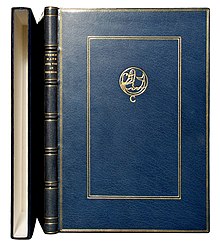Our website is made possible by displaying online advertisements to our visitors.
Please consider supporting us by disabling your ad blocker.
Morocco leather


Morocco leather (also known as Levant, the French Maroquin, Turkey,[1] or German Saffian from Safi, a Moroccan town famous for leather) is a vegetable-tanned leather known for its softness, pliability, and ability to take color. It has been widely used in the manufacture of gloves and the uppers of ladies' shoes and men's low cut shoes, but is commonly associated with wallets, linings for fine luggage, and bookbindings.
Despite its name, Morocco was typically not the original source of the leather. Some of the highest quality Morocco leather, usually goat skin, used in book binding was sourced from Northern Nigeria (particularly from the Hausa city-states of Kano, Katsina, and Zazzau)[2] and Anatolia (modern day Turkey).[3][4] First known production of morocco leather is attributed to pre-11th century Moors, in which alum tanned morocco leather was stained pink. While it was not common in England and in more northern parts of Europe until the 17th century, it has been established that Morocco leather was used in Italy pre-1600, as goat leather was more common there.[3] Morocco leather is valued in Western countries for its use in luxury bookbindings because of its strength, suppleness, and because it enhanced any gilding.
The leather tends to be more famous than the breed of goat that originally produced it. The leather is sourced from the Sokoto Red breed, which is indigenous to Guinea and Sudan Savannah of Nigeria and Maradi Region in Republic of Niger.[5][3]
The finest grades of Morocco leather are goatskin, but by the late 19th century other skins often were substituted in practice, particularly sheepskin and split calfskin. For example, French Morocco is a variety made of sheepskin.[6] The tanning process varied widely, but the traditional tanning material was sumac. The traditional tanning process was skilled and elaborate; according to the application, the preparation either would aim for a carefully smoothed finish, or would bring up the grain in various patterns such as straight-grained, pebble-grained, or in particular, in a bird's-eye pattern. Morocco leather is practically always dyed, traditionally most often red or black, but green, brown or other colors also were available, and in modern times there is no special constraint on color.[7][8]
- ^ Spawn, William (1983). The Evolution of American Bookbinding Styles in the Eighteenth Century. Pennsylvania: Bryn Mawr College Library. p. 32.
- ^ Sani, Abubakar Babajo (2009). "Raw Material Production for Export in Northern Nigeria: The Experience of the People in the Livestock and Allied Industries Under British Rule C. 1900-1960". African Economic History. 37: 103–127. ISSN 0145-2258. JSTOR 41756122.
- ^ a b c Habibu, Buhari; Kawu, Mohammed; Makun, Hussaina; Aluwong, Tagang; Yaqub, Lukman; Dzenda, Tavershima; Buhari, Hajarah (2017-03-31). "Influences of breed, sex and age on seasonal changes in haematological variables of tropical goat kids". Archives Animal Breeding. 60 (1): 33–42. doi:10.5194/aab-60-33-2017. ISSN 2363-9822.
- ^ Cambridge University Press
- ^ "The Red Maradi Goat (Capra hircus)".[permanent dead link]
- ^ Ure, Andrew. A Dictionary of Arts, Manufactures, and Mines. 1853. Little, Brown.
- ^ Davis, Charles T. The Manufacture of Leather. 1885. Henry Carey Baird.
- ^ Watt, Alexander. Leather Manufacture. 1906. van Nostrand.
Previous Page Next Page


